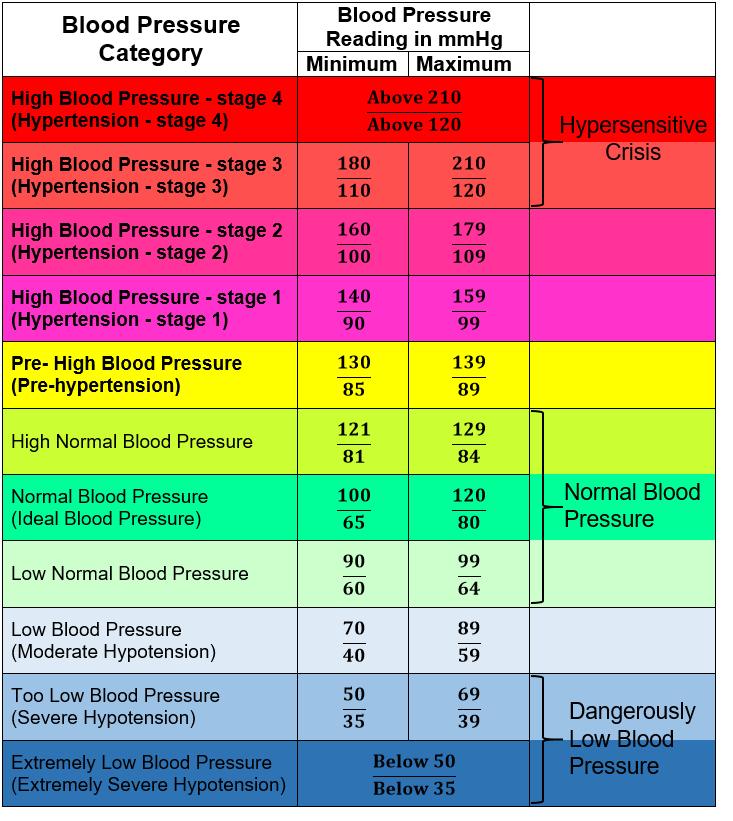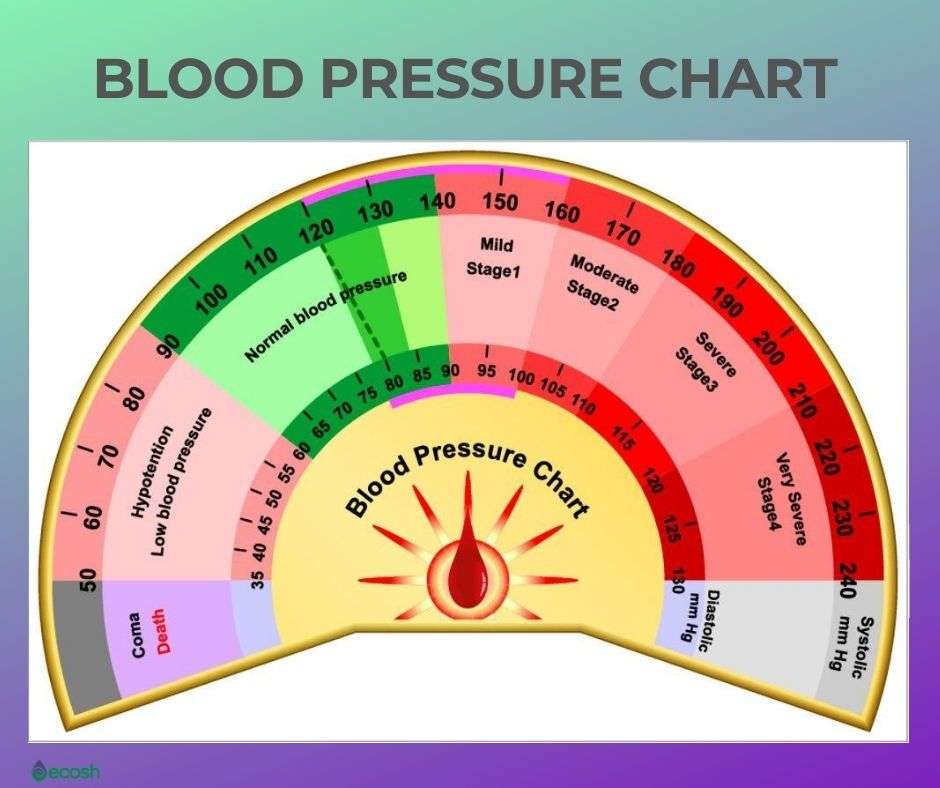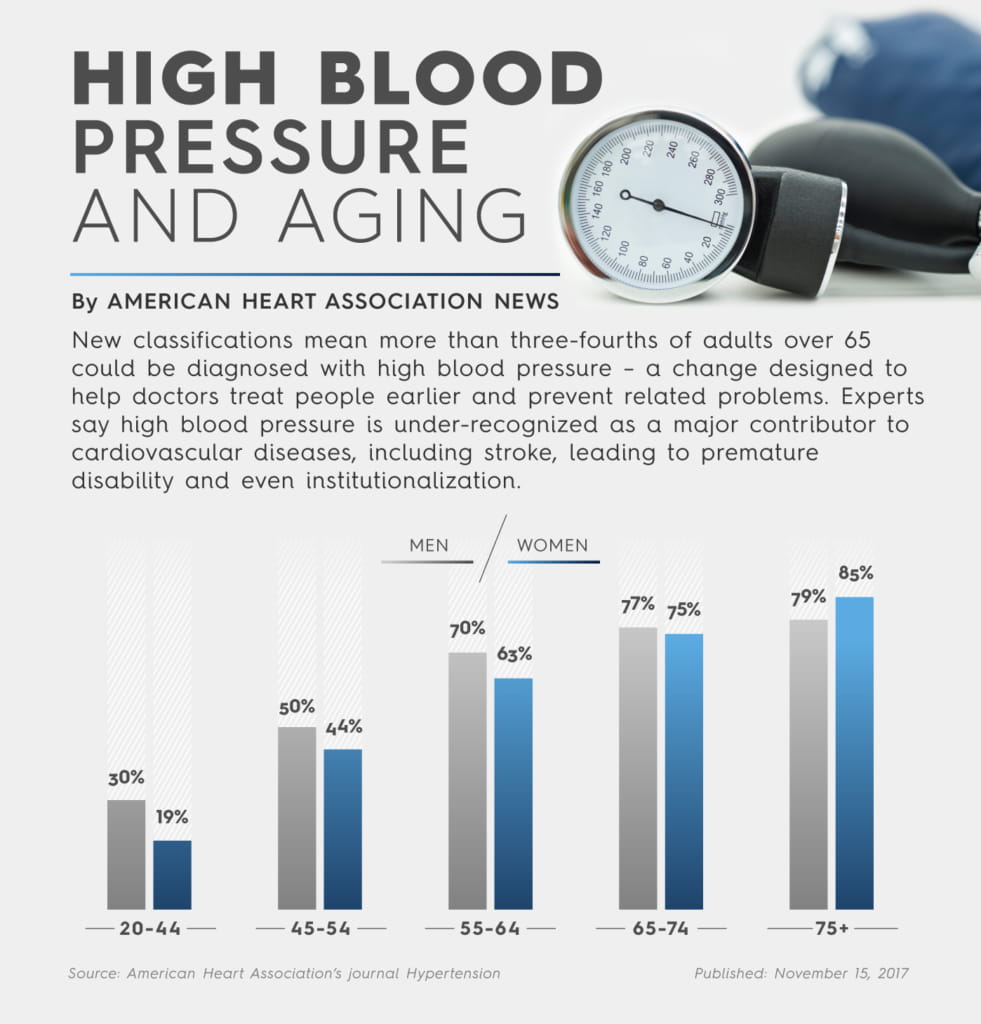Eight Blood Pressure Categories Or Classifications
Eight blood pressure categories are as below :
What blood pressure category you belong?
What Is A Blood Pressure Chart Used For
With the help of a blood pressure chart, you are able to classify your blood pressure readings into the various categories as presented in the blood pressure chart. This will help you to know the necessary measures you need to take to shift your blood pressure level to the normal blood pressure range, in case it is abnormal . If your blood pressure is normal, you will take measures to keep it within that range.
Many people who worry about their blood pressure levels can benefit by referring to a blood pressure chart or a high blood pressure chart to understand their conditions better. Monitor your blood pressure through regular check up by your doctor. You can also acquire a blood pressure monitoring device and monitor your blood pressure at home, which is more convenient.
Let us first discuss the meaning of blood pressure, how it is measured and how the readings are recorded. This will enable us to understand the blood pressure chart more easily and to be able to interpret and use it effectively.
Low And High Blood Pressure And Prehypertension
Higher than normal levels of blood pressure is known as hypertension or high blood pressure. It imposes additional strain on the arteries and the heart and is an indicative of the fact that extra pressure is exerted by the heart to pump certain amounts of blood in a certain timeframe. Aging is marked by higher blood pressure.
Lower than normal levels of blood pressure is referred to as hypotension or low blood pressure. Its effects are just the opposite of hypertension. It typically causes dizziness.
Prehypertension refers to a condition when BP levels are slightly more than normal. In such cases, the diastolic pressure may fall between 80 and 89 while systolic blood pressure may fall between 120 and 139. Patients with prehypertension are increasingly susceptible to developing high BP. However, simple lifestyle and dietary changes can help normalize it.
The official BP percentile charts by weight, height, BMI/Body Mass Index information of certain groups of adults and children are present in all clinics.
Don’t Miss: Can You Exercise With High Blood Pressure
Heart Rate Vs Blood Pressure
Blood pressure measures the force that moves blood through your blood vessels while your heart rate is the number of times your heart beats per minute. They are both important health indicators, but they are measured independently and dont necessarily increase or decrease synchronously.
A temporary increase in heart rate, such as during exercise, is not considered problematic. In fact, your heart is expected to rise during a bout of activity and return to its resting rate afterward. And the more intense you work, the more you should expect your heart rate to rise during exercise. Your heart rate can safely double during activity so long as it returns to its resting rate relatively soon after you finish your workout.
Significant increases in blood pressure, on the other hand, are not normal and should be monitored and shared with your health care provider.
How To Lower High Blood Pressure Fast

Although a blood pressure chart may help you monitor your blood pressure level, knowing how to lower blood pressure or avoid its development is also necessary. Take the following measures to reduce blood pressure in case you are diagnosed with it.
- Increase your Physical activity
- Quit or limit caffeine consumption
- Avoid tobacco smoking or chewing
- Cut down on your weight
- Manage and reduce your stress
- Eat plenty of foods that are known to lower hypertension
- Avoid or moderate on foods which may increase hypertension
- Medications prescribed by doctors
Read Also: Can I Take My Blood Pressure With My Iphone
Blood Pressure Monitor Vs Blood Pressure Cuff
Blood pressure monitor and blood pressure cuff are two phrases often used to describe the same blood pressure measurement tool. The blood pressure cuff is the element that wraps around either the upper arm, wrist or finger to measure blood pressure. The blood pressure monitor is the element in charge of inflating and deflating the cuff, as well as providing your blood pressure reading on an easy-to-read display.
Most experts recommend using a blood pressure monitor with an upper arm blood pressure cuff for at-home readings because they tend to be more accurate than wrist cuffs and finger cuffs.
Everyone Has Blood Pressure Our Blood Pressure Is Simply The Amount Of Work That Our Hearts Have To Do To Pump Our Blood Around The Body
What is blood pressure, exactly?
High blood pressure usually has no symptoms. If its not treated or kept under control, it is one of the major risk factors for heart disease and stroke. Treatment and detection is very possible but it starts with you.
Blood pressure is measured by two numbers
The first number records blood pressure when the pressure is at its highest i.e. when the heart muscle squeezes out the blood this is called systolic pressure.
The second number is when the heart relaxes and allows the blood to flow back into the heart this is called diastolic pressure.
Whats the normal level?
The normal level of blood pressure is usually about 120 over 80 . If your blood pressure is 140 over 90 or higher you should discuss this reading with your doctor.
Why is blood pressure important
The higher your blood pressure, the greater your risk of heart attack or stroke, heart failure, kidney failure and poor circulation in your legs. These problems can be avoided if your blood pressure is controlled.
Over half of all adults in Ireland over 45 years of age have high blood pressure. About 4 in every 5 men and 2 in every 3 women with high blood pressure are not being treated. Keep reading and well help change that.
If you are diagnosed with high blood pressure, it means your blood pressure is consistently higher than it should be. Thankfully, there are several ways to help reduce it which we will talk you through below.
Are there any signs or causes?
Recommended Reading: Is Apple Cider Vinegar Good For Blood Pressure
How To Measure Blood Pressure
There are two ways to check your blood pressure: using a manual or automatic blood pressure monitor. A manual blood pressure monitor consists of a cuff that is inflated with air and wrapped around your upper arm. As the cuff deflates, it measures your systolic and diastolic blood pressure readings. If you are unsure, you can also learn how to measure your blood pressure the correct way.
How Is High Blood Pressure Treated
Treatment for hypertension depends on how high your blood pressure is, as well as your lifestyle and risk factors.
For elevated blood pressure, the goal is to keep your blood pressure from developing into clinical hypertension. No medications are necessary at this stage. Your doctor may recommend:
- losing weight if you have overweight or obesity
For stage 1 hypertension, your doctor may recommend lifestyle changes as mentioned above, as well as:
- reducing your sodium intake
- finding healthy ways to manage your stress
- medication, if your blood pressure doesnt improve after 1 month of lifestyle changes
For stage 2 hypertension, the typical treatment, in addition to a healthier lifestyle, is medication. Your doctor may prescribe one or more of the following medications to help lower your blood pressure:
- ACE inhibitors to block substances that tighten blood vessels
- alpha blockers to help relax the arteries
- beta-blockers to decrease your heart rate and block substances that tighten blood vessels
- calcium channel blockers to relax blood vessels and decrease the work of your heart
- diuretics to decrease the amount of fluid in your body, including your blood vessels
A hypertensive crisis requires immediate treatment. Medications may be given orally or intravenously .
The most for a hypertensive crisis include:
- vasodilators, such as hydralazine, nitroglycerin, and nitroprusside
- beta-blockers, such as labetalol and esmolol
Don’t Miss: What’s The Ideal Blood Pressure
Average Ranges Show Normal Pressure On The Arteries
Blood pressure measures the force pressed against the walls of your arteries as your heart pumps blood through your body.
Average blood pressure differs by sex and tends to rise with age. It’s important to know how blood pressure affects your health.
This article covers how healthcare providers differentiate between “normal” blood pressure and hypertension and includes blood pressure charts by age and gender. It will also discuss the health risks involved with hypertension, how you can monitor your blood pressure, and when you should call your healthcare provider.
When To Call Your Doctor
The risks of both high and low blood pressure make monitoring your blood pressure at home essential to your overall health and well-being. Both Dr. Wong and Dr. Desai recommend calling your healthcare provider if your self-monitored blood pressure readings are greater than 180/120 mmHgeven if you have no other symptoms.
You should call 911 if these blood pressure readings are associated with symptoms of organ damage, such as headache, vision changes, weakness, numbness, chest pain or shortness of breath, says Dr. Wong.
You May Also Be Interested In Blood Pressure Monitor From Our Featured Partner
iHealth Track Blood Pressure Monitor
Read Also: How To Lower Bottom Blood Pressure Number
Treatments For High Blood Pressure
Whether you have prehypertension, or full-blown hypertension at any stage, the treatments options are the same. However, those with more severe high blood pressure may need to be more aggressive in their approach than those with blood pressure readings which are close to normal. Common treatment regimen include:
Blood Pressure Chart: High Low Or Normal For Adults & Children By Age

You can use a blood pressure chart by age and height or by gender to understand the meaning of your pressure readings. The charts provide ranges for high, low and normal pressure readings for adults and children. Statistically, high blood pressure is now one of the main causes of fatalities in the world. However, very few people understand their blood pressure readings and the acceptable level of blood pressure. A blood pressure chart may aid you keep your blood pressure within the normal range. Definitely, this will minimize chances of unprecedented complication and eventualities.
Read Also: What Can Cause Blood Pressure To Spike
What Causes Low Blood Pressure
There are many possible reasons for low blood pressure, according to both Dr. Wong and Dr. Desai, including:
- Heart problems like heart failure or low heart rates
- Endocrine problems, such as parathyroid disease, adrenal insufficiency or hypoglycemia
- Side effects of medications for high blood pressure, prostatic hypertrophy, Parkinsons disease, depression and erectile dysfunction
- Massive weight loss
- Rapid heart rate
Understanding Blood Pressure Infographic
Having blood pressure outside the normal range puts your health in jeopardy. If its too high, youre at risk of serious medical conditions, including heart attacks and stroke. Blood pressure thats too low can be life-threatening in severe cases.
Regardless, ALWAYS discuss readings and health conditions with your physician to ensure accurate results and the safest actions for your health.
Keep in mind that you can have high blood pressure and not even know it. This silent condition might be doing untold harm to your body. Knowing your numbers is the only way to find out for sure if your blood pressure readings fall within the optimal range, and making smart lifestyle choices is the only way to keep them there!
Stay consistent with your health. Use the infographic below as a reminder and helpful guide to understanding your blood pressure readings. View below or click image for free PDF 🙂
Recommended Reading: How To Check Blood Pressure At Home Without Equipment
What You Should Know About Fluctuating Blood Pressure In The Elderly
As you help monitor your loved ones blood pressure, keep in mind that if numbers fluctuate slightly throughout the day, thats normal. Several factors influence your blood pressure numbers. For example, your blood pressure may be lower if youre resting and higher if youre stressed. This means you may have a normal reading in the morning and an elevated number in the afternoon.
If youre concerned about excessive fluctuation in your loved ones blood pressure numbers, keep the following tips in mind:
- Read the instructions to ensure youre using your home blood pressure monitor equipment correctly. Variations in how you measure your loved ones blood pressure can result in different readings.
- Bring your home monitor to your next doctors appointment to compare readings.
- Be aware of white coat hypertension. In some cases, a persons blood pressure may be high at a doctors office but normal at home. This could be attributed to the stress related to a doctors appointment.
Your loved ones doctor may want you to keep a blood pressure diary with several readings a day for a couple of weeks to monitor any variations.
What Are Some Complications Related To Hypertension
Hypertension can lead to several complications, including
1. Stroke or heart attack
2. Weak and narrowed blood vessels in the kidneys
3. Aneurysm
5. Narrow, thickened, or torn blood vessels in the eyes
6. Metabolic syndrome
7. Dementia due to decreased blood flow in the brain
8. Loss of memory or trouble with understanding
Don’t Miss: How Dangerous Is High Blood Pressure
Recommended Blood Pressure Monitors
References:
Williams B, Giuseppe M, Spiering W, et al. . 2018 ESC/ESH Guidelines for the management of arterial hypertension. Journal of Hypertension, 36. doi: 10.1097/HJH.0000000000001940
Bupa . High blood pressure. Retrieved from www.bupa.co.uk/health-information/heart-blood-circulation/high-blood-pressure-hypertension
Blood Pressure Association . Blood pressure chart. Retrieved from www.bloodpressureuk.org/BloodPressureandyou/Thebasics/Bloodpressurechart
What Does The Diastolic Blood Pressure Number Mean
The diastolic reading, or the bottom number, is the pressure in the arteries when the heart rests between beats. This is the time when the heart fills with blood and gets oxygen.
This is what your diastolic blood pressure number means:
- Normal: Lower than 80
- Stage 2 hypertension: 90 or more
- Hypertensive crisis: 120 or more. Call 911.
Our chart below has more details.
Even if your diastolic number is normal , you can have elevated blood pressure if the systolic reading is 120-129.
Also Check: Can Fasting Lower Blood Pressure
Normal Blood Pressure And Heart Rate
While a rising heart rate will increase blood flow through the body, it does not necessarily correspond with an increase in the pressure of that blood flow. This is because blood vessels can increase in size to facilitate larger quantities of blood. Even if your heart rate were to double, your normal blood pressure & high pulse may only slightly increase blood pressure.
Complications Of High Blood Pressure

Untreated or poorly managed high blood pressure can cause serious and even life threatening issues. It can damage your blood vessels as well as your organs. The longer your hypertension goes untreated, the more it can damage your body and affect your health.
Potential complications of high blood pressure include:
Recommended Reading: How High Blood Pressure For Stroke
What Is Normal Blood Pressure
A normal blood pressure reading indicates that the heart and blood vessels are not working too hard pushing blood and that the blood is not exerting too much pressure on the walls of the vessels, says Aseem Desai, M.D., a cardiologist at Providence Mission Hospital in Southern California. Recent data from the American Heart Association suggests the optimal normal reading for adults over 20 is lower than 120/80 mmHgVirani S, et al. Heart disease and stroke statistics – 2021 update . American Heart Association Journal. 2021 143:e254-e743. .
Dr. Desai notes blood pressure can vary depending on a persons age, gender, race and ethnicity, but it should still fall within the general normal range. While numbers lower than 120/80 are generally considered normal, Dr. Desai adds, The target blood pressure for treatment varies depending on age and associated co-morbidities .
When Do You Measure Heart Rate Vs Blood Pressure
You should measure your heart rate when you are at rest and your blood pressure when you are active. Your heart rate is a good indicator of your overall fitness level and can help you gauge how hard you should be working when you are active. Your blood pressure is a good indicator of how much stress your body is under and can help you gauge whether or not you are at risk for hypertension.
Don’t Miss: Can Sleep Apnea Cause Pulmonary Hypertension
What Factors Influence Blood Pressure
- Age: Blood pressure tend to increase with age.
- Gender: Women after puberty have low BP than men, whereas, after menopause, women tend high BP.
- Genetics/family history: A family history puts you at risk of high BP.
- Weight: Being overweight or obese increases your risk of high BP.
- Diurnal variation: BP is lower in the morning and gradually increases throughout the day.
- Stress: BP increases during stress, emotions, fear, and anger situations due to stimulation of the sympathetic nervous system.
- Exercise: Physical activity increases BP, but regular exercises can keep BP in the lower range of normal.
- Pregnancy:Progesterone relaxes the walls of blood vessels, causing decreased peripheral vascular resistance. Some women may develop pregnancy-induced hypertension.
- Diseases: Diseases such as diabetes, kidney disease, hypothyroidism, hyperthyroidism, Cushings syndrome, and pheochromocytoma can cause high BP.
- Medications: Certain medications can affect BP such as nonsteroidal anti-inflammatory drugs, antidepressants, antianxiety medications, and prednisone.
- Alcohol or tobacco consumption: Drinking too much alcohol can increase your BP.